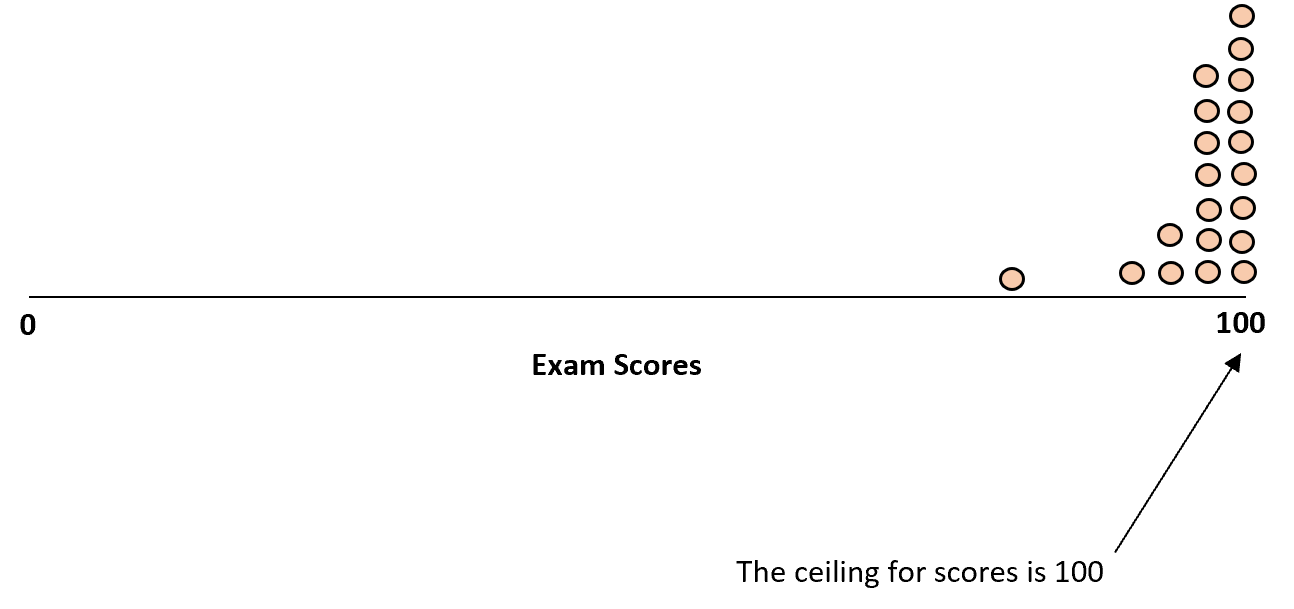In research, a ceiling effect occurs when there is some upper limit on a survey or questionnaire and a large percentage of respondents score near this upper limit.
The opposite of this is known as a floor effect.
A ceiling effect can cause a variety of problems including:
- It makes it difficult to get an accurate measure of central tendency.
- It makes it difficult to get an accurate measure of dispersion.
- It makes it difficult to rank individuals according to score.
- It makes it difficult to compare the means between two groups.

This tutorial provides several examples of ceiling effects, details on why they’re problematic, and ways to prevent them from occurring.
Ceiling Effect Examples
The following examples illustrate scenarios where ceiling effects may occur in research.
Example 1: A Questionnaire on Income.
Suppose researchers want to understand the distribution of household incomes in a particular neighborhood so they create a questionnaire to give to each household. Since they want to prevent nonresponse bias, they decide to ask households “which income bracket they fall in” and make the highest bracket $120k or more.
In this case, even if households make far more than $120k per year (e.g. suppose some make $150k, $180k, $250k or more) they will simply be grouped in the $120k or more group. If there are many households that make far more than $120k, the researchers will have no clue and they’ll likely underestimate the true household income average for the neighborhood.
Example 2: A Survey on Alcohol Consumption
Suppose researchers want to understand the alcohol consumption habits of students on a particular campus. They decide to email a short survey to each student asking how many drinks they consume per week. To prevent nonresponse bias, they make the highest category 10 drinks or more.
In this case, many of the students may actually consume far more than 10 drinks per week but the highest category they can select to be in is 10 drinks or more. This creates an artificial ceiling and it’s likely that a high percentage of respondents will fall in this category.
Example 3: An Easy Exam
Suppose a teacher administers an IQ exam that is measured on a scale of 1 to 50. Without realizing it, she makes the exam a bit too easy and a large percentage of the class scores at or near a perfect score of 50.
Because of this, it will be difficult for her to rank the scores of the students in any type of order and she won’t be able to distinguish which students could have performed even higher on a harder exam.
Problems Caused by Ceiling Effects
Ceiling effects cause a variety of problems including:
1. It makes it difficult to get an accurate measure of central tendency.
If a large percentage of respondents score at or near the highest possible value in an exam, questionnaire, or survey, it will become difficult to get an accurate measure of what the “average” score should be.
2. It makes it difficult to get an accurate measure of dispersion.
Similarly, if many respondents score near the highest possible value on an exam or survey, it will make it seem as if there is less dispersion than there really is because it’s not possible for respondents to score abnormally high.
3. It makes it difficult to rank individuals according to score.
If many individuals receive a perfect score on an exam, it becomes impossible to rank the individuals in any way since many of them received the same score.
4. It makes it difficult to differentiate between two groups.
Suppose a researcher wants to know if two different studying techniques lead to different average exam scores. If the exam is too easy then most of the students in each group will score near the max possible value, which will make it impossible to compare the average exam scores between each group to determine if the studying technique made any difference.
How to Prevent Ceiling Effects
There are two common ways to prevent ceiling effects:
1. In surveys and questionnaires, provide anonymity and don’t set artificial ceilings on responses.
For example, in a questionnaire about household incomes researchers need to reassure respondents that their answers will be completely anonymous and allow respondents to fill in their actual income instead of selecting from brackets.
This will increase the likelihood that respondents will provide their true income since their answer will be anonymous and it will allow researchers to understand the actual income distribution without extremely high incomes being masked from the responses.
2. Increase the difficulty of exams or tests.
For exams and tests, it’s important that researchers increase the difficulty so that a smaller percentage of individuals are able to score at or near a perfect score.
This will allow researchers to gain an accurate understanding of the mean and the dispersion of the data. This will also allow researchers to be able to rank the scores of individuals since fewer individuals are likely to receive the same score.